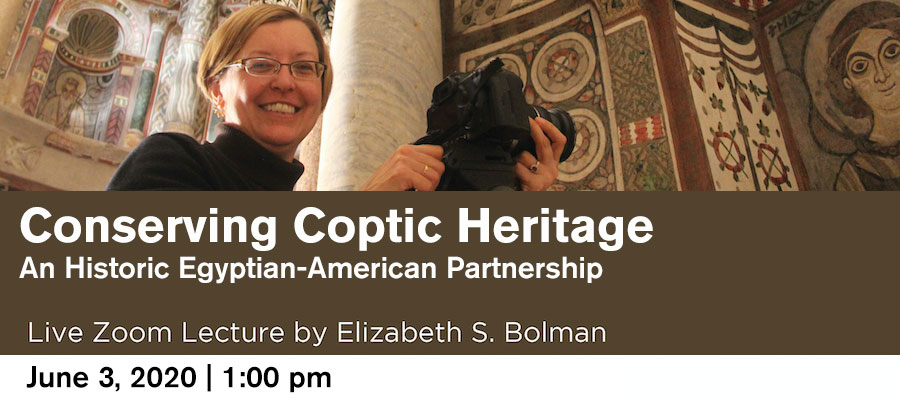Conserving Coptic Heritage: An Historic Egyptian-American Partnership, live Zoom lecture by Elizabeth S. Bolman (Case Western University), June 3, 2020, 1:00 pm
An historic partnership between the United States Agency for International Development (USAID), the American Research Center in Egypt (ARCE), the Egyptian Ministry of Tourism and Antiquities and the Coptic Orthodox Church has brought to life three spectacular Coptic churches and the earliest painted Christian tomb in Egypt. At the start, these monuments were only known within Egypt and to a small group of Coptologists (specialists in the history of the Copts). Now, all four are shining examples of the Christian tradition of creating wall paintings featuring holy figures, for devotional purposes.
The earliest, the Tomb of St. Shenoute at the White Monastery, dates to the middle of the fifth century C.E. Monks at the Red Monastery built a magnificent painted church in the late fifth century, and repainted it two more times in quick succession. Over thirty patrons paid to have a major program of wall paintings created in the Old Church at the Monastery of St. Antony, in the early thirteenth century. The tradition of painting large-scale religious images on the walls of churches in Egypt died out in or shortly after the fourteenth century. Monks in the Monastery of St. Paul revived it in the early eighteenth century, using for some of their inspiration the thirteenth-century paintings in the nearby Monastery of St. Antony. Major wall painting conservation and publication projects at these four sites revealed treasures that had not been seen for centuries. Previously ignored by scholars of the larger medieval world, these monuments and their painted interiors are now seen as making major contributions to the corpus of medieval art. The Egyptian/USAID/ARCE partnership has caused a fundamental rethinking of the role of Egypt in the creation of eastern Mediterranean visual culture, and has added four jewels to world heritage.
Elizabeth S. Bolman is Elsie B. Smith Professor in the Liberal Arts and Chair of the Department of Art History, Art and Art Education at Case Western Reserve University. She engages with the visual culture of the eastern Mediterranean in the late antique and Byzantine periods. She is best known for her work in Egypt, in which she has demonstrated the vitality of Christian Egyptian art and presented new understandings of the nature of artistic production in the early Byzantine and Medieval periods.
Registration is required, at least 48 hours in advance. There will be a Q&A period afterwards.
